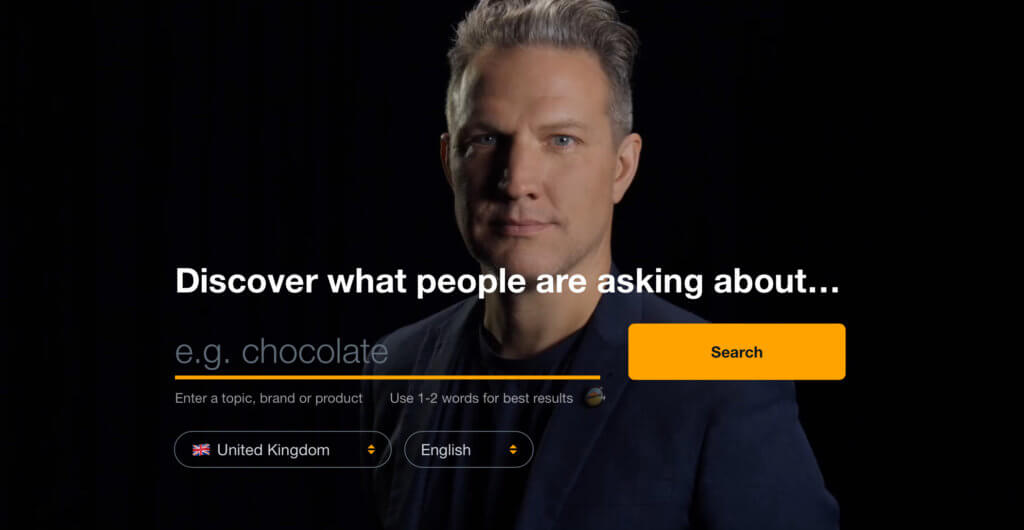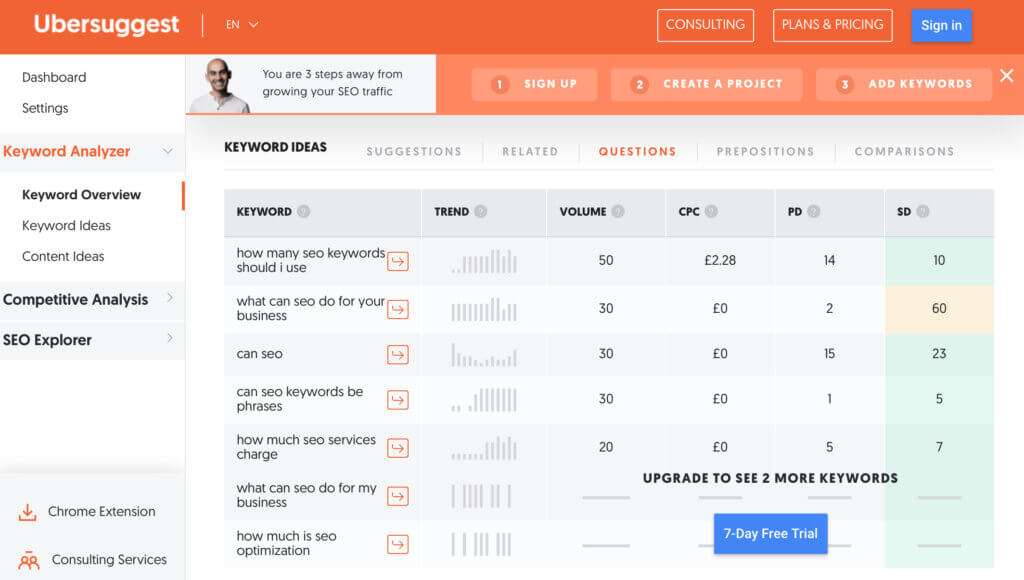SEO is a forever-changing and evolving form of marketing. It’s a long-term game that unlike PPC can work continuously for you. Having a solid SEO content strategy is key.
It stands for Search Engine Optimisation. It’s the art of improving your website’s visibility on search engines by improving where your website ranks on Google (or Bing).
One of the core components is knowing what search phrases, or ‘keywords’, your target audience is using.
There has been an interesting shift in recent times with the type of keyword shifting from a specific word or phrase to question-based searches.
Let’s take an example of one of our services and the keyword ‘SEO’.
If someone was looking to improve their website’s SEO they might have searched for something like ‘SEO tips’ or ‘SEO best practices‘. But based on current trends, this type of search may now take the form of a question such as…
How do I improve my SEO?
Or
How do I improve my website’s SEO?
According to recent research by Backlinko, 14.1% of all (Google) searches now take the form of a question.
The most common type of question is “how”, followed by “what”, “where” and “why”, “who” and “which”. Image below from Backlinko:
Questions would be considered as long-tail keywords. They are longer and often more specific than a normal keyword. Because of this search volumes can be lower, but if you rank high enough for relative phrases, you stand a good chance of that query converting. To be more specific, the searcher would often be further along in the buyer’s journey.
How do I know what questions people are asking?
There are quite a few tools available to help you find out what these questions are so that you can start to form your SEO content strategy.

One such great resource is Answer The Public. Here you can find out what questions are being asked about any given topic.

Neil Patel’s Ubersuggest also has a tool which provides question-based keyword ideas when you perform keyword analysis.
Google search can also provide you with some great insights when you search in the form of the question and answer based Featured Snippets which we’ll talk about later.
A good starting point is also knowing and understanding what questions your customers/potential customers regularly ask you. Then use Ubersuggest to see if those questions could yield a high search volume.
The trick with keywords is to find those which have a decent search volume, yet a fairly low search difficulty rating. These are those for which you have a better chance of ranking and will bring in a decent number of visitors to your site.
You ask we answer
There is another benefit to having question-based content, and it’s a key component of the inbound marketing methodology which we fully embrace.
Improving your rankings aside, answering questions that potential customers are asking will provide them with great valuable content, and start to build trust with them.
They may be at an early stage of their buying process, but if you are providing great content which is helping them, you can help nurture them through to the buying decision.
A key champion of this process is Marcus Sheridan, who has written a book based on this concept called They Ask You Answer.
I was lucky enough to see a presentation by Marcus where he explained how taking a new approach to marketing for one of his earlier jobs (River Pools) had led him to establish 5 key topics around which your question and answering-based content should focus. It transformed the success of River Pool’s digital marketing efforts and saved them from going under after the 2008 economic crash.
The concept was simple, rather than fighting for keywords just to answer people’s questions.
The Big 5
The 5 key topics to base them on he calls The Big 5:
- Pricing and cost. Eg “How much does ____ cost?”
- Problems. Eg “what are the cons of _____?”
- Comparisons. Eg “what’s better, _____ or _____?”
- Reviews. Eg “what do people think of _____?”
- Best in class. Eg “what’s the best____?”
Some of these questions do rely on there being a certain amount of honesty about things we as business owners may not usually talk about outside of proving a proposal.
Take pricing for example. Most B2B businesses will not list their prices online. Maybe they don’t want their competitors to know what they charge. Or they would rather provide value-based pricing direct to the client.
By answering questions about pricing, surely it is showing transparency and thus building trust?
The big 5 also cover all stages of the buyer’s journey. So you can attract traffic from customers at all stages.
When you start answering questions like comparisons or reviews, you know the buyer has established their problem and is looking for the best solution.
Questions, questions. A key part of your SEO content strategy
When performing a Google search, have you seen a box appear which has a selection of questions and their related answers right there on the search page?
These are called Featured Snippets.
They make finding content easier for users as they can see it right there in Google without needing to leave the page. These boxes often appear high up on the page. You may get some alternative options too, usually titled People also ask.
To try and get your content to appear here, you have to make use of schema data. It’s basically bits of information in the code around the content which tells Google it’s question-based content.
The good news is you don’t need to be able to code. If you use WordPress and have the Yoast SEO plugin installed, you can set this up.
Here’s some guidance on setting up FAQ-based content: https://yoast.com/how-to-build-an-faq-page/
There is also a Q&A-type schema. Make sure you use the Q&A schema when there is just one question and the FAQ schema for multiple questions.
Conclusion
Taking this approach to your SEO content strategy can provide a great starting place for your content plan. We all know what questions we get asked the most when dealing with new and existing customers, so why not write them down?
It needs to be an integral component of your overall digital marketing strategy.
Remember to write for the user first. It’s all about providing them with a fantastic user experience. Just make sure to do your keyword research and make sure your content is high quality, informative and engaging. Build trust and nurture your leads.
Get in touch to learn more about what SEO content strategy you should be using in 2022.
What SEO content strategy should I use in 2022?
Posted: 15 December 2021 by Jason Lawes. Reading time: 6 minutes
Home » You Ask We Answer » What SEO content strategy should I use in 2022?
SEO is a forever-changing and evolving form of marketing. It’s a long-term game that unlike PPC can work continuously for you. Having a solid SEO content strategy is key.
It stands for Search Engine Optimisation. It’s the art of improving your website’s visibility on search engines by improving where your website ranks on Google (or Bing).
One of the core components is knowing what search phrases, or ‘keywords’, your target audience is using.
There has been an interesting shift in recent times with the type of keyword shifting from a specific word or phrase to question-based searches.
Let’s take an example of one of our services and the keyword ‘SEO’.
If someone was looking to improve their website’s SEO they might have searched for something like ‘SEO tips’ or ‘SEO best practices‘. But based on current trends, this type of search may now take the form of a question such as…
How do I improve my SEO?
Or
How do I improve my website’s SEO?
According to recent research by Backlinko, 14.1% of all (Google) searches now take the form of a question.
The most common type of question is “how”, followed by “what”, “where” and “why”, “who” and “which”. Image below from Backlinko:
Questions would be considered long-tail keywords. They are longer and often more specific than a normal keyword. Because of this search volumes can be lower, but if you rank high enough for relative phrases, you stand a good chance of that query converting. To be more specific, the searcher would often be further along in the buyer’s journey.
How do I know what questions people are asking?
There are quite a few tools available to help you find out what these questions are so that you can start to form your SEO content strategy.

One such great resource is Answer The Public. Here you can find out what questions are being asked about any given topic.

Neil Patel’s Ubersuggest also has a tool which provides question-based keyword ideas when you perform keyword analysis.
Google search can also provide you with some great insights when you search in the form of question and answer-based Featured Snippets which we’ll talk about later.
A good starting point is also knowing and understanding what questions your customers/potential customers regularly ask you. Then use Ubersuggest to see if those questions could yield a high search volume.
The trick with keywords is to find those which have a decent search volume, yet a fairly low search difficulty rating. These are those for which you have a better chance of ranking and will bring in a decent number of visitors to your site.
You ask we answer
There is another benefit to having question-based content, and it’s a key component of the inbound marketing methodology which we fully embrace.
Improving your rankings aside, answering questions that potential customers are asking will provide them with great valuable content, and start to build trust with them.
They may be at an early stage of their buying process, but if you are providing great content which is helping them, you can help nurture them through to the buying decision.
A key champion of this process is Marcus Sheridan, who has written a book based on this concept called They Ask You Answer.
I was lucky enough to see a presentation by Marcus where he explained how taking a new approach to marketing for one of his earlier jobs (River Pools) had led him to establish 5 key topics around which your question and answering-based content should focus. It transformed the success of River Pool’s digital marketing efforts and saved them from going under after the 2008 economic crash.
The concept was simple, rather than fighting for keywords just to answer people’s questions.
The Big 5
The 5 key topics to base them on he calls The Big 5:
- Pricing and cost. Eg “How much does ____ cost?”
- Problems. Eg “what are the cons of _____?”
- Comparisons. Eg “what’s better, _____ or _____?”
- Reviews. Eg “what do people think of _____?”
- Best in class. Eg “what’s the best____?”
Some of these questions do rely on there being a certain amount of honesty about things we as business owners may not usually talk about outside of proving a proposal.
Take pricing for example. Most B2B businesses will not list their prices online. Maybe they don’t want their competitors to know what they charge. Or they would rather provide value-based pricing direct to the client.
By answering questions about pricing, surely it is showing transparency and thus building trust?
The big 5 also cover all stages of the buyer’s journey. So you can attract traffic from customers at all stages.
When you start answering questions like comparisons or reviews, you know the buyer has established their problem and is looking for the best solution.
Questions, questions. A key part of your SEO content strategy
When performing a Google search, have you seen a box appear which has a selection of questions and their related answers right there on the search page?
These are called Featured Snippets.
They make finding content easier for users as they can see it right there in Google without needing to leave the page. These boxes often appear high up on the page. You may get some alternative options too, usually titled People also ask.
To try and get your content to appear here, you have to make use of schema data. It’s basically bits of information in the code around the content which tells Google it’s question-based content.
The good news is you don’t need to be able to code. If you use WordPress and have the Yoast SEO plugin installed, you can set this up.
Here’s some guidance on setting up FAQ-based content: https://yoast.com/how-to-build-an-faq-page/
There is also a Q&A-type schema. Make sure you use the Q&A schema when there is just one question and the FAQ schema for multiple questions.
Conclusion
Taking this approach to your SEO strategy can provide a great starting place for your content plan. We all know what questions we get asked the most when dealing with new and existing customers, so why not write them down?
It needs to be an integral component of your overall digital marketing strategy.
Remember to write for the user first. It’s all about providing them with a fantastic user experience. Just make sure to do your keyword research and make sure your content is high quality, informative and engaging. Build trust and nurture your leads.
Get in touch to learn more about what SEO content strategy you should be using in 2022.









